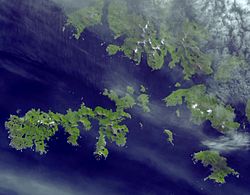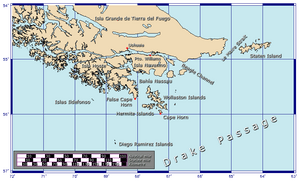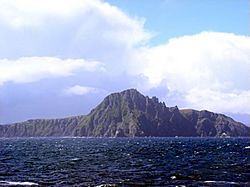Cape Horn facts for kids

Cape Horn (called Kaap Hoorn in Dutch and Cabo de Hornos in Spanish) is a famous piece of land that sticks out into the ocean. It's known as a "cape." This cape got its name from the city of Hoorn in the Netherlands.
Cape Horn is the very southernmost part of the Tierra del Fuego group of islands in southern Chile. Many people think of it as the southern tip of South America. It's also the most southerly of the "great capes" that sailors used to navigate around the world. Just south of Cape Horn is the Drake Passage, a wide stretch of ocean.
For hundreds of years, Cape Horn was a super important spot on the "clipper route." This was a major sea path that sailing ships used to carry goods all over the world. However, the waters around Cape Horn are very dangerous. There are strong winds, huge waves, and even icebergs. Because of these dangers, it became known as a place where many sailors and ships were lost.
Today, the Panama Canal has made it much easier for large cargo ships to travel between the Atlantic and Pacific oceans without going around Cape Horn. But even now, sailing around Cape Horn is seen as a huge challenge for people who enjoy yachting. Many adventurous sailors still try this route, sometimes as part of a trip around the whole world. Some big ocean races, like the Vendée Globe, even include sailing around Cape Horn as part of their course.
Contents
What is Cape Horn?
Cape Horn is a rocky headland, which means it's a high piece of land that sticks out into the sea. It's located on Hornos Island, which is part of the Hermite Islands group. These islands are the southernmost part of the Tierra del Fuego archipelago. An archipelago is a group of many islands.
Where is Cape Horn located?
Cape Horn is found in southern Chile, a country in South America. It's at the very bottom of the continent. The coordinates for Cape Horn are about 55°59′ South latitude and 67°16′ West longitude. This means it's very far south, close to Antarctica.
History of Sailing Around the Horn
For centuries, sailing around Cape Horn was one of the toughest challenges for sailors. Before the Panama Canal was built, ships had to go all the way around South America to get from the Atlantic Ocean to the Pacific Ocean, or vice versa.
Why was it so dangerous?
The waters around Cape Horn are known for being very rough.
- Strong Winds: Powerful winds, often called "roaring forties" or "furious fifties" (because of the latitudes they blow in), constantly sweep across the area.
- Huge Waves: These strong winds create massive waves, sometimes as tall as buildings, which can easily damage ships.
- Icebergs: Because it's so close to Antarctica, icebergs can drift into the shipping lanes, posing a hidden danger to ships.
- Currents: Strong ocean currents also make sailing difficult and unpredictable.
Many ships were lost and many sailors died trying to navigate these dangerous waters. This is why it earned the nickname "sailors' graveyard."
The Clipper Route
The "clipper route" was a fast way for clipper ships to travel between Europe and Asia or Australia in the 1800s. These ships were built for speed. Even though the route around Cape Horn was dangerous, it was often faster than other options, like sailing around Africa's Cape of Good Hope. Ships carried valuable goods like wool, tea, and gold on this route.
Cape Horn Today
With the opening of the Panama Canal in 1914, ships could pass directly between the Atlantic and Pacific oceans through Central America. This made the long and dangerous journey around Cape Horn mostly unnecessary for cargo ships.
Modern Challenges and Races
Even though it's no longer a main trade route, Cape Horn remains a symbol of adventure and a major challenge for sailors.
- Yachting: Many recreational sailors dream of "rounding the Horn" as a personal achievement. It's considered one of the ultimate tests of sailing skill and endurance.
- Ocean Races: Several famous round-the-world yacht races, like the Vendée Globe, require sailors to pass Cape Horn. These races are solo, non-stop, and without outside help, making the challenge even greater.
- Speed Records: Sailors trying to set new speed records for sailing around the world often follow the traditional clipper route, which includes passing Cape Horn.
Images for kids
-
The voyage of Willem Schouten and Jacob Le Maire in 1615–16, when they first sailed around Cape Horn.
-
Cape Horn as seen during the United States Exploring Expedition, depicted in watercolor by Alfred Thomas Agate.
See also
 In Spanish: Cabo de Hornos para niños
In Spanish: Cabo de Hornos para niños









